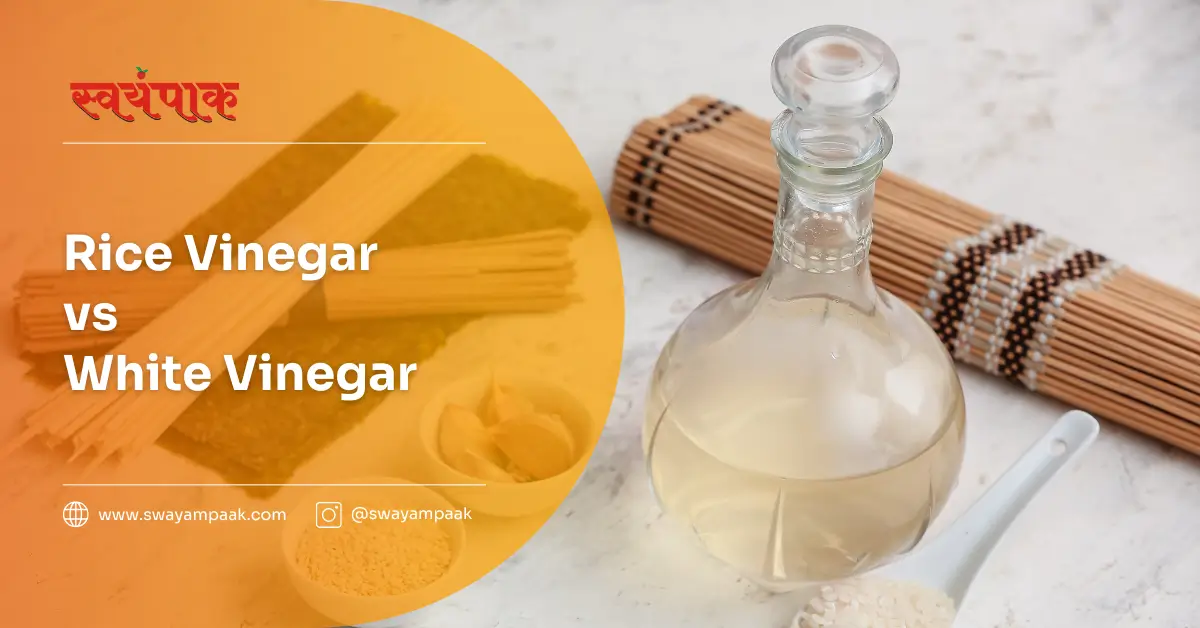Ever stood in the grocery store staring at the vinegar aisle, wondering what makes each variety unique? You’re not alone! Among the many options, rice vinegar and white vinegar stand out as pantry staples, but they couldn’t be more different in their origins, uses, and flavours.
Whether you’re a culinary enthusiast looking to perfect your Asian cuisine, a home cook seeking healthier alternatives, or simply curious about these kitchen essentials, understanding their distinct characteristics is key to elevating your cooking game.
In this post, we’ll dive deep into six fascinating facts about Rice Vinegar vs White Vinegar, helping you make the perfect choice for your next recipe or DIY project.
- What is Vinegar?
- What is Rice Vinegar?
- What is White Vinegar?
- Rice Vinegar vs White Vinegar: Key Differences
- Uses of Rice Vinegar in Cooking
- Uses of White Vinegar in Cooking
- Health Benefits of Rice Vinegar
- Health Benefits of White Vinegar
- Which Vinegar is Better for Cooking?
- Which Vinegar is Better for Cleaning?
- Substituting Rice Vinegar with White Vinegar (and Vice Versa)
- Rice Vinegar vs White Vinegar for Pickling
- Conclusion
What is Vinegar?
Vinegar is a versatile acidic liquid that has been used for thousands of years in cooking, preservation, and cleaning. At its core, vinegar is the result of a fascinating two-step fermentation process: first, sugars are converted into alcohol by yeast, and then special bacteria called Acetobacter transform that alcohol into acetic acid, giving vinegar its characteristic sour taste.
The name itself comes from the French term “vin aigre,” meaning “sour wine,” which hints at its ancient origins. While it typically contains 4-8% acetic acid, vinegar can be made from virtually any sugary or starchy source, leading to a wide variety of types including wine vinegar, apple cider vinegar, rice vinegar, and the common white vinegar made from grain alcohol.
Beyond its culinary applications in marinades, dressings, and pickling, vinegar has earned its place in households worldwide for its natural cleaning properties, potential health benefits such as blood sugar control, and antimicrobial characteristics. This humble ingredient’s remarkable versatility and natural preservation abilities have made it an indispensable part of human culture and daily life.
Here, we will look into Rice Vinegar vs White Vinegar and compare them with a set of properties and uses in various culinary dishes and cuisines.
What is Rice Vinegar?
Rice vinegar, a staple in Asian cuisines, is made by fermenting rice. Its roots trace back to East Asia, where it is celebrated for its mild, slightly sweet flavour.
- Production Process: Rice vinegar is created by fermenting rice into alcohol and then fermenting the alcohol into acetic acid.
- Types of Rice Vinegar:
- White Rice Vinegar: Mild and light in flavour.
- Black Rice Vinegar: Rich and smoky, often used in Chinese dishes.
- Red Rice Vinegar: Tangy with a hint of sweetness.
- Taste Profile: Known for its delicate sweetness and low acidity, rice vinegar is less harsh than other types of vinegar, making it perfect for dressings, marinades, and sushi rice.
What is White Vinegar?
White vinegar, also known as distilled vinegar, is a widely used type of vinegar with a sharp, acidic flavour.
- Production Process: It’s typically made from the fermentation of distilled alcohol derived from grains, resulting in pure, clear vinegar.
- Types of White Vinegar:
- Distilled White Vinegar: The most common form, with around 5-10% acetic acid.
- Industrial White Vinegar: Often used for cleaning purposes, with a higher acidity level.
- Taste Profile: White vinegar is known for its intense sourness and strong acidic taste, which can overpower other flavours in some dishes.
Rice Vinegar vs White Vinegar: Key Differences
Understanding the differences between rice vinegar and white vinegar is essential to using them effectively in the kitchen:
- Ingredients and Production:
- Rice vinegar is made from fermented rice.
- White vinegar is distilled from grain alcohol.
- Acidity Level:
- Rice vinegar has a lower acidity, around 4%.
- White vinegar has a higher acidity, ranging from 5% to 10%.
- Taste and Flavor Profile:
- Rice vinegar is mild, sweet, and delicate.
- White vinegar is sharp, tangy, and overpowering.
- Colour and Appearance:
- Rice vinegar is often translucent or pale yellow.
- White vinegar is completely clear.
Uses of Rice Vinegar in Cooking
Rice vinegar, a staple of Asian cuisine, is crafted from fermented rice wine. Its gentle sweetness and delicate acidity set it apart from sharper vinegar, making it an exceptionally versatile ingredient.
While it’s best known for seasoning sushi rice, this nuanced condiment adds depth and balance to countless dishes across Eastern and Western kitchens.
- Sushi and Rice
- Seasoning sushi rice
- Brightening plain rice dishes
- Making quick-pickled vegetables (sunomono)
- Dressings and Sauces
- Asian-style vinaigrettes
- Dipping sauces
- Sweet and sour sauce
- Cold noodle dressings
- Marinades
- Tenderizing meat
- Adding brightness to seafood
- Quick pickling solutions
- Stir-fries and Cooking
- Balancing rich or fatty dishes
- Deglazing pans
- Adding acidity to soups and broths
- Common Substitutes:
- Lemon juice (in some cases)
- Apple cider vinegar (slightly stronger)
- White wine vinegar
Uses of White Vinegar in Cooking
White vinegar, made from grain-based ethanol, is one of the most versatile ingredients in your kitchen. With its sharp, clean flavour and high acidity, it serves as both a powerful cooking ingredient and a kitchen problem-solver.
While it may lack the complexity of other vinegar, its pure, straightforward tartness makes it ideal for everything from pickling vegetables to tenderizing meat. Budget-friendly and shelf-stable, white vinegar has earned its place as a pantry staple in cuisines worldwide.
- Pickling & Preserving
- Making quick pickles
- Canning vegetables
- Preserving fruits
- Basic brine solutions
- Baking
- Buttermilk substitute (mixed with milk)
- Activating baking soda
- Making meringues more stable
- Improving pie crusts
- Meat & Fish
- Tenderizing meat
- Fish and chip vinegar
- Balancing rich dishes
- Hot sauce base
- Kitchen Preparation
- Poaching eggs
- Keeping white vegetables white
- Cleaning produce
- Cutting greasiness
- Sauces & Dressings
- Basic vinaigrettes
- BBQ sauce ingredient
- Marinades
- Quick sauce brightener
- Common Applications
- Boiling better-poached eggs
- Making homemade mayonnaise
- Preventing discoloration in boiled potatoes
- A base for hot pepper sauces
Health Benefits of Rice Vinegar
Rice vinegar isn’t just about flavour; it offers health benefits too.
- Nutritional Content: Contains small amounts of nutrients and amino acids.
- Antioxidants: May help reduce inflammation and improve gut health.
- Low-Calorie Option: A light way to add flavour without extra calories.
Health Benefits of White Vinegar
White vinegar also brings some health perks to the table.
- Antibacterial Properties: Helps eliminate bacteria in foods and surfaces.
- Blood Sugar Control: Studies suggest it may help stabilize blood sugar levels.
- Digestive Aid: Its acidity can support healthy digestion.
Which Vinegar is Better for Cooking?
Rice vinegar and white vinegar each serve distinct purposes in cooking, making it difficult to declare one “better” than the other. Rice vinegar, with its mild, slightly sweet profile and 4-5% acidity, excels in Asian cuisine and dishes where subtle flavour balance is crucial, such as sushi rice, light dressings, and delicate marinades. It’s generally more expensive but preserves the nuanced flavours of other ingredients.
White vinegar, on the other hand, brings a sharp, intense flavour and higher acidity (5-7%), making it the go-to choice for pickling, baking, and strong marinades. It’s more affordable and offers superior preservative properties, though it can overwhelm delicate flavours.
The choice between the two ultimately depends on your specific cooking needs: rice vinegar is ideal for Asian dishes and light preparations, while white vinegar excels in preservation, baking, and situations requiring stronger acidity. Rather than competing, these vinegars complement each other in a well-stocked kitchen, each serving its own essential purpose.
Which Vinegar is Better for Cleaning?
Rice vinegar and white vinegar serve very different purposes when it comes to cleaning, with white vinegar being the clear winner for household cleaning tasks. White vinegar’s higher acidity (5-7%), lack of colour, and affordable price make it ideal for cleaning and disinfecting.
It effectively cuts through grease, removes stains, eliminates odours, and kills certain bacteria, all while being environmentally friendly and non-toxic. Additionally, it leaves no residue and its strong smell dissipates quickly.
Rice vinegar, while slightly acidic, is significantly more expensive and contains sugars and additional compounds that could leave behind residue or even attract pests. Its lower acidity also makes it less effective for cleaning purposes.
Rice vinegar is best reserved for culinary uses, while white vinegar’s chemical composition, cost-effectiveness, and cleaning power make it the superior choice for household cleaning tasks, from descaling coffee makers to cleaning windows and removing soap scum from bathrooms.
Substituting Rice Vinegar with White Vinegar (and Vice Versa)
In some cases, rice vinegar and white vinegar can be substituted, but adjustments are needed:
Substituting White Vinegar for Rice Vinegar:
- Use 1 tablespoon white vinegar + ¼ teaspoon sugar for every tablespoon of rice vinegar
- Best for: pickling, marinades, and stronger-flavored dishes
- Not recommended for sushi rice, delicate Asian dressings
- Reduce the amount used by about 25% due to higher acidity
- Consider adding a pinch of salt to balance the flavours
Substituting Rice Vinegar for White Vinegar:
- Use 2 tablespoons of rice vinegar for every tablespoon of white vinegar
- Best for: light dressings, quick marinades
- Not recommended for pickling, baking, or strong cleaning tasks
- May need to increase the amount due to lower acidity
- Won’t provide the same preservation properties
General Tips:
- Taste and adjust as you go
- Consider the dish’s overall flavour profile
- Be mindful of acidity differences
- Remember rice vinegar is sweeter
- For Asian dishes, prioritize finding rice vinegar
Success depends on:
- Type of dish
- Cooking method
- Desired final flavour
- Recipe requirements
- Preservation needs
Rice Vinegar vs White Vinegar for Pickling
Pickling requires precision, and the choice of vinegar matters:
White Vinegar for Pickling
- Higher acidity (5-7%) makes it ideal for preservation
- Crystal clear appearance maintains vegetable colour
- Neutral flavour lets ingredients shine
- More cost-effective for large batches
- Industry-standard for long-term pickling
- Better shelf stability and preservation
- A traditional choice for American-style pickles
Rice Vinegar for Pickling
- Lower acidity (4-5%) means less preservation power
- Adds subtle sweetness to pickled foods
- Best for quick pickles (refrigerator pickles)
- Perfect for Asian-style pickled vegetables
- More expensive for large batches
- Shorter shelf life for preserved foods
- Traditional for Japanese and Korean pickles
Best Applications:
White Vinegar:
- Long-term preservation
- Traditional dill pickles
- Large batch canning
- Root vegetables
- Mixed vegetable pickles
Rice Vinegar:
- Quick cucumber pickles
- Asian pickled vegetables
- Pickled ginger (gari)
- Daikon radish
- Short-term refrigerator pickles
Conclusion
In conclusion, while both rice vinegar and white vinegar have their place in the kitchen, they serve distinctly different purposes. Rice vinegar shines with its mild, sweet profile that elevates Asian cuisine and delicate dressings, while white vinegar’s sharp, intense acidity makes it ideal for pickling, cleaning, and recipes that need a strong punch of sourness.
Health-conscious cooks might prefer rice vinegar for its subtle flavour and potential antioxidant properties, while budget-minded homemakers may reach for the more versatile and economical white vinegar.
Understanding these differences helps you choose the right vinegar for your specific needs, whether you’re crafting a delicate sushi rice or mixing up an all-natural cleaning solution. Both vinegars are valuable pantry staples that prove t/hehe incredible versatility of fermented foods in our daily lives.


